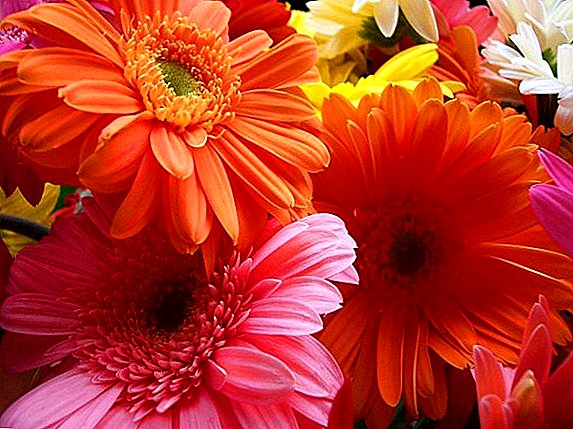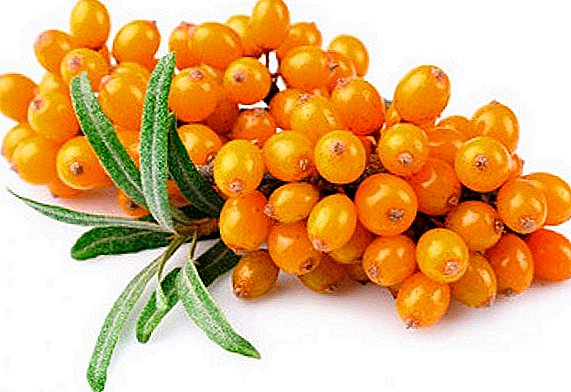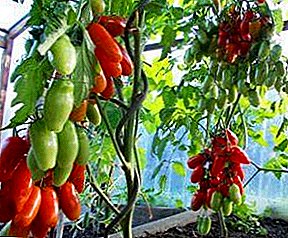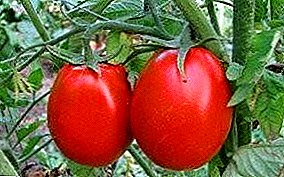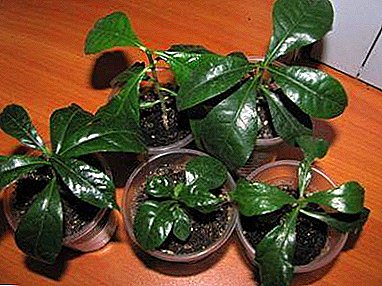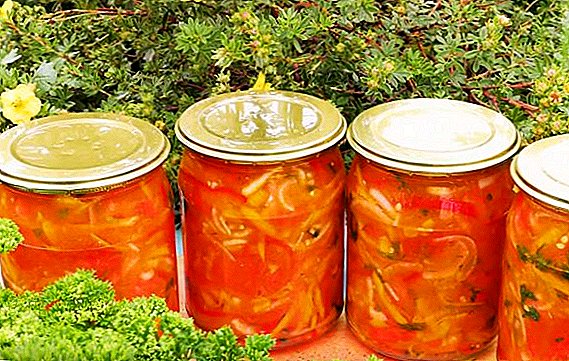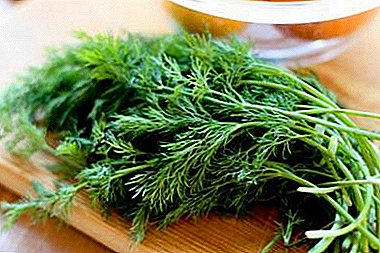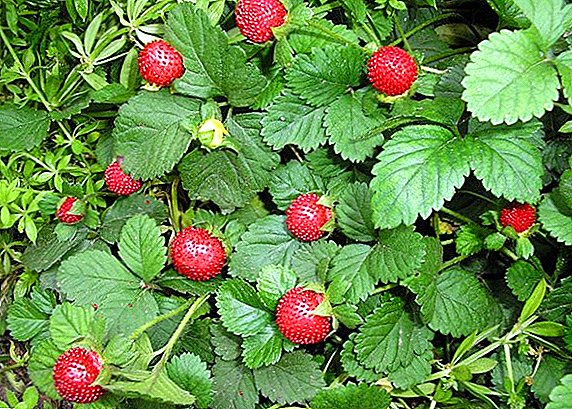
Potentilla Indian - original ornamental and medicinal plants - many names. It is called Indian or false strawberry, as well as Indian dusheney, pseudo-earthy, fragaria and dushenya. Externally, it is very similar to ordinary strawberries: the same three-piece leaves, mustaches, small bright red berries, but the taste qualities of Duchenae are significantly inferior. Dushenay is grown as an ornamental plant in the garden, in hedges and even in pots on a balcony or windowsill, and it is difficult to distinguish it from real strawberries.
Plant description
Duchenei indian is a perennial herb with creeping hairy stems. On the stems grow trifoliate leaves on the petioles, which grow from the rosette rosette.
Other species of silverweed are also popular with gardeners: white and shrub.

Did you know? French botanist of the 18th century, Antoine Duchesne, described Indian Potentilla, and in honor of him, it got its name - Ducheneus.The plant intensively produces shoots reaching half a meter in length.
Potentilla flowers are located singly, their diameter is 1.5 cm, located on the peduncles. The flower has a corolla of five petals, the color is yellowish or creamy, and this is one of the differences between dusheney and strawberry. The flower has 20-30 stamens and a small pestle.
Flowering plant from the beginning of the summer and throughout the season. In Potentilla fruits resemble strawberries and are round berries of red color, densely covered with small seeds.
The second difference is that strawberry berries are hung downwards, and the fruits of duchenae stretch upwards.
Did you know? Despite the fact that the strawberry and Dushenay Indian - relatives and both belong to the Rosy family, and their taste is very different. Strawberries have a rich taste and aroma, fruits of Dusheney - tasteless and bland

It is propagated like strawberries in a vegetative way through whiskers, the outlets of which rooted quickly, you can propagate the plant by dividing the bush, as well as through seeds. As a cultivated plant has been cultivated since the beginning of the 19th century, it is unpretentious in care and tolerates frost quite firmly, however it prefers snowy or artificial shelter, it can freeze slightly without it, however it can be easily revived.
It easily transfers shadow, but prefers semi-shade areas that occur at the foot of a large tree, but do not like stagnant water. After a long drought, it may not recover, so in the hot summer you need to additionally monitor the moisture content of the soil surface, which has plant roots.
The climate of this culture prefers a moderate: wet or warm, capable of rapid recovery while maintaining a few surviving outlets. The composition of Dushene is rich in:
- sugars;
- fiber;
- organic acids;
- substances pectin, nitrogenous, tannic;
- alkaloids;
- salts of some metals: iron, calcium, phosphorus, manganese;
- vitamins B, C, carotene, folic acid.
Habitat
The place of growth of Potentilla Indian - South and East Asia, it is believed that its homeland - the forests of the Eurasian and American continents. In a state of wild growth - this is a weed plant, similar to wild strawberries.
We cultivate as an ornamental, as well as a garden plant everywhere: from Siberia to the southern territories. Potentilla like loamy and sandy soils in a fairly moist but not too moist condition. Indian strawberries are grown in gardens as a ground-cover perennial, as well as a pot plant.
Mesembryantemum, alissum, silver dichondra, armeria, stonegrass, nemophila, zhivkuchka as well as ducheney belong to ground cover plants.
Due to its extremely decorative appearance, the silverweed looks excellent as an element of landscape design in various compositions, but its ability to “creep away” does not allow the plant to be used in miniature alpine slides.
But thanks to this quality, Dusheney is planted in places where it is necessary to quickly occupy space, for example, between trees and bushes. She has nothing against the coniferous neighborhood.

Important! Being a perennial plant, the Duchenaea loses the decorative effect of its bushes every season, and the culture needs to be renewed every spring. Unlike garden strawberries, it does not need to be transplanted to a new place, the patchula is renewed at the place of its main growth.
Outdoor planting
In the open ground Dusheney Indian prefers penumbra, but growing it in sunny areas is also possible with sufficient watering. In the care of Ducheney, it is unpretentious, she likes the soil light or medium, for planting in open ground and pots the following is recommended: two parts of leafy soil and one part of sod and sand. You can also use the purchase of universal soil.
Did you know? It is believed that the world-famous drawings in the style of "Khokhloma" Russian masters depicted not forest, but Indian strawberries. This view is supported by the yellow tint of the flowers of the depicted plant. And this is not surprising, since a century ago Ducheney was widely used as an ornamental plant, although it was called in the gardening reference books of those years. "fragaria".

As a homemade plant, potentilla perfectly decorates the interior. She is beautiful and pleases the eye with her appearance. The plant feels comfortable enough, even if the temperature drops to 5 ° C.
In the summer, pots of bushes are put on a place where there is light, but there is no direct sun and enough fresh air. In winter, they should be moved to where it is light, but the temperature is much lower - about 12-15 ° C.
Breeding
Exists three ways of reproduction of this ornamental plant:
- division of the bush;
- rooted outlets with a mustache;
- seeds.
During the growing season, a tendril grows with a rosette located on the rosette of the bush, which roots in the ground, without separating it from the mother bush until it is stronger and develops its own root system. If the silverweed grows in the ground and is already thick enough, you can substitute for the outlet a container with the ground in which the daughter outlet can take root, and subsequently divide the plants.

Sometimes gardeners buy plant seeds and grow crops from them. If the seeds are stratified, their growing time is reduced from 6 weeks to 1-2, and the seedlings are more friendly. Stratification is carried out as follows: a container with seeds sown in the ground is placed in a refrigerator and remains there for a week. After growing up, the seedlings dive into their personal containers.
Important! If you have chosen the breeding of Indian Dusensei from seeds, keep in mind that flowering will occur in the first year of life.Potentilla often growing in the soil multiplies self-sowing.
Care
Indian strawberries are not particularly capricious, and care she needs is minimal:
- remove dried fragments for a better view, cutting them as close as possible to the base;
- do not remove faded flowers from the stems, because of them beautiful bright berries will develop, so decorating the plant; when they lose their attractiveness and turn brown, they are removed by cutting them off from the flower stalks on which they grew;
- it is advisable to water the plant regularly, especially strawberries in pots: in them the soil is supposed to be evenly hydrated, growth slows down during the cold season, and the plant is relatively calm, therefore it needs less watering;
- in summer season, Indian strawberries are sprayed from time to time;
- in spring, cinquefoil is fed with complex fertilizer, it is introduced into the soil before planting;
- Dushene requires light, but not direct sunlight, but scattered, in the peak of the heat it is desirable to shade it, hiding it from the sun;
- frosts can harm the plant, especially if the winter is snowless, therefore duchenite growing in open ground should be covered for winter, while the specimens growing in the pots need to be provided with a temperature regime of 10-15 ° С by placing them in a room, greenhouse or greenhouse;
- Indian strawberries like snails and slugs are no less than garden ones; therefore, plants growing in the ground are protected in the same way - they put pebbles, a special purchased substance, crushed eggshell, and so on; pot plants are hung directly in pots or plaster their edges with petroleum jelly;
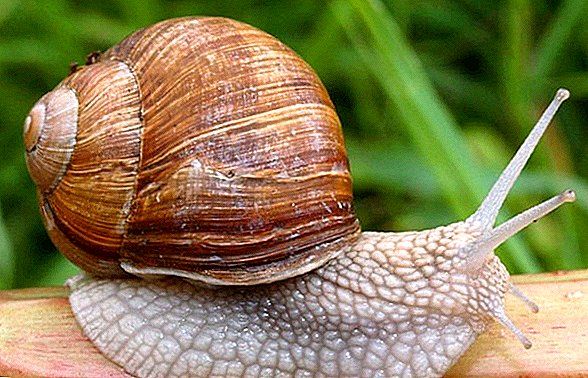
- If the plant is affected by pests, it should be treated with an insecticide that kills them.

Did you know? Latin name Potentilla - Potentila - it is derived from the Latin noun potentis, which means strength, power. Such a name is given to paws not in vain, they have long been famous for their healing properties, as well as their life force.
Pharmacological properties
Duchenei Indian has an antitumor effect, the polyphenols in its composition have such beneficial properties that fight cancer cells and destroy them. This was proven by American researchers, who discovered such an effect during experiments on bats.
Asian residents have long known and used the healing properties of plants, including for the prevention and improvement of cancer.
Antitumor effect has many plants: red currant, celandine, aconite, bathing suit, purple stonecrop, hellebore, periwinkle, wormwood, mint, lily of the valley, barberry.
Preparation of raw materials
Both the leaves and the fruits of Potentilla Indian have healing properties. They are harvested for further use. 
Important! Berries are eaten fresh, but you can also use dried and frozen, however, the number of nutrients in them is somewhat reduced.When the receptacle turns dark red and is easy to separate. - it's time to harvest. Drying is carried out in a special dryer, oven, oven. Drying temperature - 45-50 degrees. Dried berries should be stored in a tightly closed glass container in a dark place at room temperature. Their shelf life is 2-3 years.
The leaves are dried in the shade in a place that is well ventilated. They are sometimes turned over for uniform drying, stored in a dry dark place. It is not recommended to store raw materials for more than 2 years.
Use in traditional medicine
Domestic medicine does not apply Indian duchenaea, but its healing properties are widely used in Asian countries. Traditional medicine gives it such properties:
- antitumor;
- antiseptic;
- anti-inflammatory;
- tonic
- organs of the digestive system;
- liver;
- pancreas;
- oncological diseases.

The Chinese use the antiseptic properties of the juice for the treatment of:
- stomatitis;
- wound healing;
- and even as a snake antidote.
- neurosis;
- insomnia;
- depressed.
Dusheni fruits are part of face masks.
Contraindications
The berries are tasteless, and many consider them inedible, suitable only in decorative quality. Superficially resembling a strawberry, they have nothing to do with it, except perhaps the useful elements that make up them.
Important! When eating a large number of Dusheni berries for food, you may feel unwell, because they contain a small amount of toxic substances.

It is not recommended to use them children, pregnant and lactating women, people prone to allergic reactions, as well as those with individual intolerance to the plant and its components.
Whether to use the properties of Dusheni Indian as a medicinal plant is a personal matter. There is no doubt that it is magnificent as an ornamental plant, both growing in open ground and planted in pots for interior decoration.




